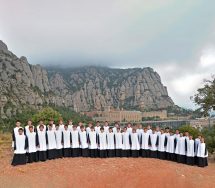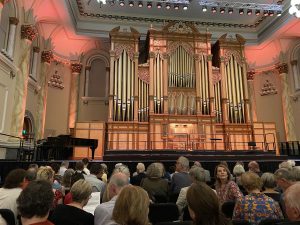Escolania De Montserrat

(AF, Adelaide Town Hall, 4 March 2023)
Founded in the 13th century, this ensemble is the oldest extant boys’ choir in the world and its rigorous training and selection criteria ensure its standards never slip. The choirboys of Escolania are taught the Benedictine sacred repertoire at the Santa Maria de Montserrat Abbey in Catalonia (established in 1,025AD). Their core duty is to enliven pilgrims who come to Montserrat, so to see them on tour – 36 of the full complement of 50 – is quite special.

Llorenç Castelló (see below) conducted the choir, who entered the Hall from the back, singing a Gregorian chant (full programme below). Pieces ranged from the full historical liturgical works to Catalan folk songs, contemporary pieces, the classic prayer to the Virgin (a daily work at the monastery) Salve Regina, (a rather terrifying piece, with the Town Hall’s great organ blasting out Hammer Horror sounds) and of course, Ave Maria. The choir was dynamic, changing places and disporting themselves about the stage and on one occasion, the audience floor, with the precision and timing of expert Swiss Guards or football players. This ‘surround sound’ presentation was sublime. Accompaniment was sparse, once with a lonely tambourine and hand drum, but generally either via the grand organ or grand piano, both brilliantly executed by Mercè Sanchis. The young men, in their crisp black and white smocks, sang as if they were angels. (It makes you regret the inevitability of puberty.)
The Programme:
ESCOLANIA SINGS TO THE VIRGIN
Germinans germinabit
Gregorian chant (Introit of the Solemnity Mass to Our Lady of Montserrat, that the Escolania used to sing every morning around the main altar of the church.)
Llibre Vermell
Inperayritz
Codex XIV century (Written in the 14th century, the Montserrat Codex contains different sections (religious and astronomical, for example) and a songbook of ten medieval songs and dances dedicated to the Virgin Mary, the result of the pilgrims’ devotion to the Virgin. It is a polyphonic motet, adapted to three voices, in which the figure of the Virgin Mary is praised.)
Anselm Viola (1738 – 1798)
Magnificat (Anselm Viola is considered one of the most prestigious musicians of the Montserrat music school. He devoted himself to his life’s work, which was teaching music to the choristers. His musical task was not limited to teaching, however, as he found time to compose musical works to cater for the religious requirements of the monastery. The vocal and instrumental works of Viola that have been preserved reveal a mature and prolific composer, up-to-date with the modern techniques and forms of his time. His style is characterised by highlighting especially graphic parts of the text with a correspondingly expressive musical setting, as well as by unexpected modulations.)
Àngel Rodamilans (1874-1936)
Moreneta en sou (Father Rodamilans is, without doubt, a special, rare and unique composer with a strong and charismatic personality and whose works have a characteristic mark that never leaves someone the same. The works from his dense and daring final period (with Moreneta en sou, for example), takes inspiration from the works of the first era, yet demonstrate a constant interest in evolving to a more complex and innovative style. We shall never forget the compositional bravery of Rodamilans, who didn’t want to follow certain norms or rules put in place by the era, but instead valued his own freedom of imagination and expression.)
Bernat Vivancos (b.1973)
Two liturgical pieces to the Virgin:
Ave Maria (from Ave Maria by Franz Schubert) (“I arranged it [Schubert’s Ave Maria] for my wedding… I found it ready-made!” said Bernat Vivancos with a grin, proof of his fascination for, and natural acceptance of, the mysteries of creativity. To open one’s eyes and let oneself be caressed by Ave Maria is to discover the effect of harmony in the minor key which, after the surprise of the initial disruption of expectations, becomes delectable in the unexpected expressive quality of the melody.)
Salve Regina (The Salve Regina is the prayer that the Escolania sings to the Virgin Mary every day at 1pm. This text has been set to music by many composers of very different styles and eras. The one we present to you comes from a contemporary aesthetic, which employs canatabile fragments, delicacy fragments and ferocious organ interludes. The composer, of international recognition, was a student at the Escolania and was also the director of the choir between 2007 and 2014.)
CATALAN FOLKSONGS AND COMPOSERS
Francesc Civil (1895-1990)
La gata i el belitre (The cat and the scoundrel) (A Catalan folk song of a humorous nature that narrates the vicissitudes in the relationship between a cat and a dog. It is harmonised by Francesc Civil, a former chorister of Montserrat. He goes beyond the simple adaptation and harmonisation to finally become a new creation, developing the themes, making variations and adding new melodies.)
Bernat Vivancos (b.1973)
L’ametller (The almond tree) (Inspired by a poem by Catalan writer Joan Margall’s poem, Bernat Vivancos’ L’ametller (“The Almond Tree”), presents us with a landscape where the arpeggiated resonances of the piano surround a serene, three-voiced melody. The piece creates a painting of very personal tones.)
Josep Ma. Ruera (1900 – 1988)
La nostra dansa (Our dance) (This is an example of the sardana, a typical Catalan dance. This choir sardana has a fresh, bright and playful character with a high musical quality, reflecting the importance that Ruera gave to the sardana and the need to spread it at all levels.)
Bernat Vivancos (b.1973)
El cant dels ocells (The song of the birds) (A Catalan folk song, popularised by Pau Casals,this work narrates the announcement of the birth of the Infant Jesus through the refined song of the birds in the sky. The harmonisation adopts a neutral and modal language without ever disfiguring the main melody, always present, enveloped by an aura of sound that aims to be constant and uniform.)
Albert Guinovart (b. 1962)
Three pieces from El Bestiolari:
Aranya de sostre (Common spider)
Rossinyol viatger (Travelling nightingale)
Ull de bou de festa major (The chiffchaff of the festival) (These are three playful poems dedicated to three creatures: the common spider, the nightingale and the common chiffchaff. Music, always at the service of the word, plays, laughs and gets excited, giving rise to three small musical gifts.)
Leave a comment...
While your email address is required to post a comment, it will NOT be published.



0 Comments